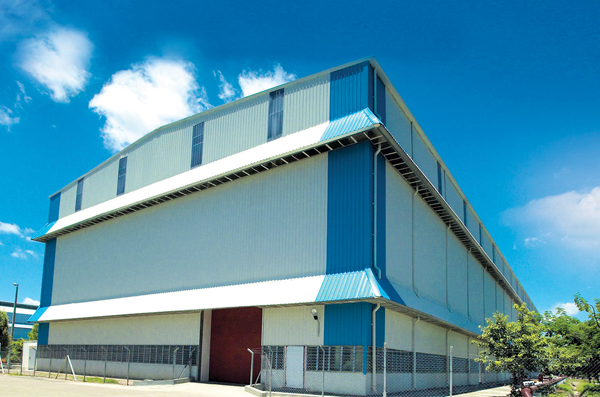A paradigm shift
[vc_row][vc_column][vc_column_text]The ongoing government programmes under the different ministries such as 'Power for all by 2022', integrated logistics park etc. would trigger a healthy growth trajectory for structural steel segment writes Renjini Liza Varghese Manual to mechanical and now to automatic, machine operations had taken a kangaroo leap from manual to automated with remote controlled access

[vc_row][vc_column][vc_column_text]The ongoing government programmes under the different ministries such as 'Power for all by 2022', integrated logistics park etc. would trigger a healthy growth trajectory for structural steel segment writes Renjini Liza Varghese
Manual to mechanical and now to automatic, machine operations had taken a kangaroo leap from manual to automated with remote controlled access there witnessed a paradigm shift in the way the machines are operated now. Take any sector as a case, one could see the massive up-gradation in every segment of the business. Integration of AI for better efficiency and performance is the new thing on the block.
It is no different in the construction segment. The shift is towards structural steel or Pre Engineered Building (PEB) material in the last decade. Unlike the earlier days, heavy engineering constructions world over have moved towards PEB. This is majorly because of the factors like time-saving, cost-effective and efficient performance.[/vc_column_text][vc_column_text]The increased use of heavy material industries are the primary growth drivers of structural steel. The manufactures of structural steel are increasingly investing in R&D operations to improve the quality like corrosion resistance, strength, and durability. This would have a positive impact on the global structural steel industry.
While India is firmly putting its foot in PEB, structural steel segments, the global market have advanced much ahead. According to a report published by the Global Banking and Finance “The global structural steel market size is estimated to reach USD 141.49 billion by 2026 growing at a CAGR of 5.6 per cent during the forecast period. The global market is highly competitive and moderately fragmented. Mergers & acquisitions and joint ventures are some of the key strategies undertaken by the major market players in the industry.”
At the global front, different countries are moving towards achieving maximum electrification, has further strengthened the transmission tower market. This, in turn, has led to increased utilisation of structural steel for manufacturing different types of transmission towers.
As per a report Published by Mordor intelligence titled, “India Structural Steel fabrication market - growth, trends and forecast (2019 - 2024),” sees the India structural steel fabrication market is expected to grow at a CAGR of 5.5 per cent over the forecast period.[/vc_column_text][vc_column_text]The report continues to say, “The Indian structural steel market is expected witness significant growth during the forecast period owing to factors such as the increasing demand from the manufacturing sector, the rising preference towards pre-engineered buildings and components, and government initiatives for infrastructure development activities.
The expected increase in steel prices due to the increase in the price of coking coal, primary raw material used to manufacture steel, the governmental regulations and restrictions on the manufacturing of steels to reduce adverse effects on the environment have been identified to be few of the significant challenges faced by the structural steel fabrication market in India.
Also, the booming commercial building sector combined with the government of India's initiatives such as increasing the construction of green buildings, smart cities, and make in India scheme is expected to boost the structural steel fabrication market in India.”
The extensive application of structural steels in power transmission lines, towers, construction, and manufacturing sheds cleaned with increased awareness among the consumers for sure will pull the demand further. Interestingly the broader use of structural steel in residential development and non-residential would also drive the growth in the near term.
Apart from a large factory and building structures, structural steel sees its primary demand from the power transmission segment. Different types of structural steel constitute the transmission towers on which the high-capacity electricity lines are fitted on.
In India, with the aggressive capacity addition in terms of transmission lines and last-mile connectivity to ensure the 'Power for All by 2022' target structural steel has a long handing fruit to en-cash on. That is not all, after the rollout of the game-changing tax regime - GST, manufacturing companies are shifting their cargo from self-developed storage spaces to the third party owned large warehouses. The integrated logistical park that is being built in the different parts of the country also will accelerate the structural steel demand.
The advantages the structural steel players in the country enjoys include a) India is one of the world's largest steel producer in the world with 106.5 MT b) The availability of steel in the domestic market at a competitive price c) cost-effective labour. Riding on these, the establishing sustaining the structural steel segment was easier.[/vc_column_text][vc_column_text]Why structural steel
Climate Change is here and a reality. The rising environmental impacts are encouraging governments, manufacturers and consumers to use environmentally sustainable products, which is further expected to escalate the demand for structural steel. Major manufacturers are developing technically advanced steel products which can help in waste reduction and can be suitably recycled. Buildings made by these products do not include mandates such as treatments for preventing insect infestation, mould, and decay, which is anticipated to strengthen market growth.
India's National Steel Policy, 2017, has envisaged 300 million tonnes of production capacity by 2030-31. There is a tremendous scope for growth exists in India as the countries per capita steel consumption is meager compared to global peers. With an economy that is growing and a demand surge seen from the infrastructure, real estate segments, Indian structural steel market is all set to grow at a healthy pace.[/vc_column_text][/vc_column][/vc_row]
Hits: 425

















